Are you a Quiet Speculation member?
If not, now is a perfect time to join up! Our powerful tools, breaking-news analysis, and exclusive Discord channel will make sure you stay up to date and ahead of the curve.
A few days ago, my buddy commented on Jeskai Control's baby-renaissance. "Why are people hopping back on UWR?" he wondered. "It looks worse than Grixis. It seems slower, too." I dropped some serious knowledge on him: "It's not a question of 'worse' or 'slower.' UWR Control has a great Grixis Control matchup, since Grixis Control is really a midrange deck. Midrange decks lose to control decks, which have a stronger late game." His eyes sparkled, and roaring applause shook the stadium. "You should write an article on that!"

My buddy suffers from a common problem: he doesn't understand deck archetypes. Many articles already exist on this subject: most are dated, none specifically address this format, and I disagree with the lines some draw to divide the archetypes. Today's article describes classic and hybrid archetypes as I see them in relation to Modern. Understanding the interactions between Magic archetypes helps players build better decks, play better games, and ultimately, win more.
[wp_ad_camp_1]
Characterizing Decks
Before getting into the archetypes, we'll look at other ways to characterize decks. Breaking decks into categories helps us understand how different archetypes evolve and interact with each other. I judge decks by three separate metrics.
Proactive vs. Reactive: Proactive decks consistently impact the game zones (hands, boards, and life). Reactive decks stop opponents from impacting these zones. Every deck must take a proactive role eventually, or it will never win.
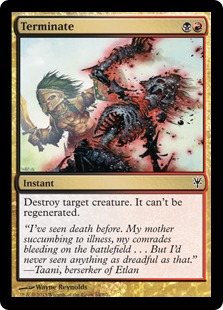 For example, Grixis Control is very reactive, walking opponents into Remand, Spell Snare, and Terminate before taking over with a Tasigur. But against Burn, a deck with more speed and inevitability than Grixis, it's forced into a proactive role, trying to land a delve creature and attack for lethal before getting toasted by Lava Spikes.
For example, Grixis Control is very reactive, walking opponents into Remand, Spell Snare, and Terminate before taking over with a Tasigur. But against Burn, a deck with more speed and inevitability than Grixis, it's forced into a proactive role, trying to land a delve creature and attack for lethal before getting toasted by Lava Spikes.
Based on the amount of time a deck plays the proactive or reactive role in most metagames, we can assign one role or the other. For more on identifying in-game roles, see the Mike Flores classic, "Who's the Beatdown?"
Interactive vs. Linear: The interactive deck addresses an opponent’s plays throughout the game. Linear decks ignore opponents to further their own gameplans, but can pack some interaction (Pact of Negation in Amulet Bloom; Pyroclasm in Tron).
Fair vs. Unfair: A fair deck wins by attacking with creatures, which it does over the course of a game, and not only on the final one or two turns (as a Reanimator deck might). Unfair decks win in nontraditional ways, usually by violating fundamental game rules.
Classic Archetypes: Aggro, Control, Combo
Of Aggro, Control, and Combo, only Combo enjoys heavy representation in Modern. Hybrids that blend one or more of these three classic archetypes make up most of the format.
Aggro
Aggro decks wage all-out assault on an opponent's life total with creatures and without much disruption of their own. Aggro decks hope to race opponents, who either try to race back or to disrupt them beyond functionality. Most Aggro decks in Modern utilize combo elements and don't fall into this section. Some consider Burn, which usually wins with reach, an unfair Aggro-Combo deck; since it leans so heavily on creatures, I've included it here. Aggro decks are proactive, linear, and fair.
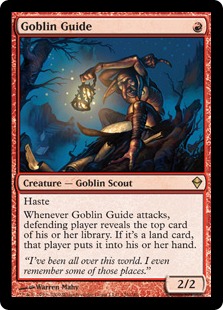 Strong against: Tempo and some Combo. Historically, Combo beats Aggro, as it's a turn or more faster. But the turn-four rule keeps Combo decks no faster than Aggro, meaning Aggro decks sometimes race Combo in Modern. Aggro decks containing reach also do well against reactive Control decks, as reach gives Aggro inevitability: eventually, they will draw more Lightning Bolts than opponents have Negates.
Strong against: Tempo and some Combo. Historically, Combo beats Aggro, as it's a turn or more faster. But the turn-four rule keeps Combo decks no faster than Aggro, meaning Aggro decks sometimes race Combo in Modern. Aggro decks containing reach also do well against reactive Control decks, as reach gives Aggro inevitability: eventually, they will draw more Lightning Bolts than opponents have Negates.
Soft to: Proactive Midrange decks, which can stabilize relevant game zones before Aggro delivers the killing blow, and faster Combo decks.
Example decks: Burn, Mono-Green Stompy, 5-Color Humans
Control
Control decks answer an opponent's cards one-for-one, making "value trades" along the way to gradually accumulate card advantage. Once it's assembled enough card advantage, Control wins with a big threat, a manland, or a planeswalker's ultimate. These decks are reactive, interactive, and unfair.
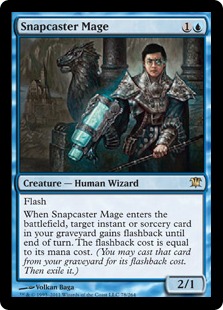 Strong against: Aggro, Midrange, and Combo. Control's sweeper effects, supplemented with one-for-one removal, puts Aggro decks in a tough spot - they can over-commit to deal more damage, opening themselves up to Wrath of God, or try to get by on single threats at a time, handing Control decks enough turns to stabilize. Midrange decks weaken their aggro plan to devastate fair decks, making them easy prey for the unfair Control decks that want to "go longer." Counterspells, hand disruption, and hate cards easily break up Combo's synergies.
Strong against: Aggro, Midrange, and Combo. Control's sweeper effects, supplemented with one-for-one removal, puts Aggro decks in a tough spot - they can over-commit to deal more damage, opening themselves up to Wrath of God, or try to get by on single threats at a time, handing Control decks enough turns to stabilize. Midrange decks weaken their aggro plan to devastate fair decks, making them easy prey for the unfair Control decks that want to "go longer." Counterspells, hand disruption, and hate cards easily break up Combo's synergies.
Soft to: Decks built to do more more in a late game (i.e. Tron) and Tempo. Tempo decks complicate Control's plan of accruing value with expensive spells; Sphinx's Revelation and Cryptic Command rarely resolve against cheap, soft permission. Aggro-Combo decks sometimes play the tempo role well enough to beat Control. Burn, which doesn't rely on creatures to deal the finishing blow, also beats it.
Example decks: UWR Control, Esper Teachings, Lantern Control
Combo
Combo decks focus on assembling a combination of cards that offers the pilot an immediate victory, or at least a very high chances of one. 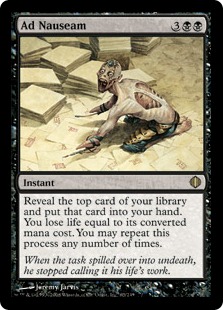 Combo decks rarely care about opponents and epitomize the term "unfair." Every Magic player ruefully remembers the first time they lost to a Combo deck. These decks are proactive, linear, and unfair.
Combo decks rarely care about opponents and epitomize the term "unfair." Every Magic player ruefully remembers the first time they lost to a Combo deck. These decks are proactive, linear, and unfair.
Strong against: Most Aggro decks and Midrange lacking adequate disruption for unfair decks.
Soft to: Control and Tempo, the former of which prevents combos from resolving and the latter of which does so while cheap bodies force Combo decks to go off early.
Example decks: Ad Nauseam, Grishoalbrand, Amulet Bloom
Combo-Paired Hybrids
Aggro-Combo
Along with Midrange, Aggro-Combo takes up one of the largest Modern metagame shares. 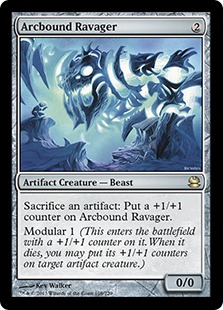 Each strategy attacks from such a unique angle that it becomes difficult to metagame against Aggro-Combo decks as a whole: enchantment hate and Spellskite do wonders against Bogles, but nothing against Elves; Pyroclasm hoses Elves, but Affinity and Bogles frequently ignore it. These blazing-fast decks possess some of the most streamlined cores in the format. Aggro-Combo is proactive, linear, and unfair.
Each strategy attacks from such a unique angle that it becomes difficult to metagame against Aggro-Combo decks as a whole: enchantment hate and Spellskite do wonders against Bogles, but nothing against Elves; Pyroclasm hoses Elves, but Affinity and Bogles frequently ignore it. These blazing-fast decks possess some of the most streamlined cores in the format. Aggro-Combo is proactive, linear, and unfair.
Strong against: A lot, but nothing specific. Aggro-Combo decks decimate Midrange decks that don't pack the right hate and are quick enough to keep a host of slower strategies from ever entering the format. They can sometimes out-aggro Tempo decks or race other Combo decks.
Soft to: Anyone who came prepared, as Modern's hate cards take no prisoners. Aggro-Combo decks also lose to Tempo decks with Disrupting Shoal.
Example decks: Affinity, Elves, Infect
Control-Combo
Control-Combo uses tempo to control the pace of a game until it wins in one fell swoop. (Many of Modern's "Control" decks win by attacking, and begin attacking as early as the third turn, which actually categorizes them as Midrange.)  Control decks want to win in some unstoppable way after grinding games to a halt, but Control-Combo doesn't mind only temporarily delaying opponents to fire off wins in a small window. For Scapeshift, the only real Control-Combo deck in Modern, that window resides between assembling seven lands and losing to a Siege Rhino opponents finally resolve through four Remands. Control-Combo is reactive, interactive, and unfair.
Control decks want to win in some unstoppable way after grinding games to a halt, but Control-Combo doesn't mind only temporarily delaying opponents to fire off wins in a small window. For Scapeshift, the only real Control-Combo deck in Modern, that window resides between assembling seven lands and losing to a Siege Rhino opponents finally resolve through four Remands. Control-Combo is reactive, interactive, and unfair.
Strong against: Aggro, Combo, and Midrange. Scapeshift has enough removal for Aggro decks, enough permission for Combo, and enough inevitability to beat permission-light decks looking to go long.
Soft to: Control and Tempo, which prevent the namesake sorcery from ever resolving.
Example decks: Scapeshift
Aggro-Control Hybrids: Tempo and Midrange
Aggro-Control decks are Aggro decks slowed down with specific disruptive elements (removal, countermagic, discard, etc.) to improve matchups against either unfair or fair strategies.
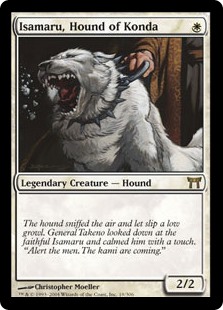 Consider a White Weenie deck that wins by going wide with undercosted 2/x's beefed up by Glorious Anthem. A Control player will happily watch the Weenie deck slam creatures every turn and shut him out of the game with an on-curve Wrath of God. If White Weenie splashes blue to address this weakness by way of, say, Spell Pierce, it becomes a Tempo Deck, sacrificing some speed for points against unfair decks.
Consider a White Weenie deck that wins by going wide with undercosted 2/x's beefed up by Glorious Anthem. A Control player will happily watch the Weenie deck slam creatures every turn and shut him out of the game with an on-curve Wrath of God. If White Weenie splashes blue to address this weakness by way of, say, Spell Pierce, it becomes a Tempo Deck, sacrificing some speed for points against unfair decks.
Consider the same Weenie deck at a different LGS, where it loses to “bigger” aggressive decks that don’t care about Spell Pierce. Isamaru, Hound of Konda matches up poorly against Watchwolf, even if the green creature comes down a turn later. Our Weenie hero compensates by splashing black instead of blue, giving himself bigger creatures that wall the aggro decks and removal to kill efficient attackers. The deck now interacts enough early on to swap its Savannah Lions for costlier, value-generating creatures like Kitchen Finks. White Weenie has become a Midrange Deck: it still attacks to win, but it sacrifices some speed for an edge against fair decks.
Aggro-Control decks are interactive and fair. Tempo decks are proactive early and reactive later, while Midrange decks are reactive first and proactive later.
 Both Tempo and Midrange use the in-game mechanic of tempo* – or, of buying time – more than any other Magic archetypes. The Tempo deck uses tempo to preserve a favorable board presence, with the goal of killing opponents before they start resolving their ostensibly “better” cards (compare Insectile Aberration to Baneslayer Angel). This deck casts Remand to buy itself another attack step while denying opponents a chance to summon a blocker with the Finks. Midrange uses tempo to find itself in a game state (i.e., the mid- or late-game) where its spells affect the game zones more than its opponent’s. It casts Remand on a turn-three Kitchen Finks to Time Walk itself into the next turn, where it can resolve a threat that will outclass the Finks.
Both Tempo and Midrange use the in-game mechanic of tempo* – or, of buying time – more than any other Magic archetypes. The Tempo deck uses tempo to preserve a favorable board presence, with the goal of killing opponents before they start resolving their ostensibly “better” cards (compare Insectile Aberration to Baneslayer Angel). This deck casts Remand to buy itself another attack step while denying opponents a chance to summon a blocker with the Finks. Midrange uses tempo to find itself in a game state (i.e., the mid- or late-game) where its spells affect the game zones more than its opponent’s. It casts Remand on a turn-three Kitchen Finks to Time Walk itself into the next turn, where it can resolve a threat that will outclass the Finks.
*Tempo here refers to a time advantage. This in-game mechanic functions similarly to card advantage, but cannot be accounted for tangibly and as a result is notoriously misunderstood. Unfortunately, we lack a separate term for Tempo decks, Aggro-Control hybrids that commit threats early, then disrupt opponents long enough to win. I’ll count on my readers to distinguish, based on context, between tempo the mechanic and Tempo the archetype. [Editor's Note: The names of the deck types are capitalized in this article to help you out.]
Aggro-Control Hybrid: Tempo
Aggro decks watered down to have an edge against unfair strategies, Tempo decks establish board presence quickly, then disrupt opponents long enough to win with that board presence. They require highly efficient threats. As a result, medium-costed creatures outclass the threats in the Tempo deck, which loses to other fair strategies.
Modern is home to two types of Tempo decks: Fish and Grow.
Fish
Named for the antheming Atlanteans that debuted the strategy, Fish decks play a large number of synergistic or disruptive creatures and some light permission. 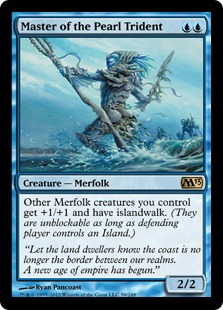 Merfolk obviously falls into this category, as does the less obvious GW Hatebears. Fish decks are mostly comprised of creatures, a few non-creature disruptive elements, and sometimes include mana dorks. About the name: I'm aware that some players exclusively call Merfolk decks "Fish." Here, I'm referring to the Fish archetype as it's historically been cited in Magic writing, and not specifically to Merfolk tribal.
Merfolk obviously falls into this category, as does the less obvious GW Hatebears. Fish decks are mostly comprised of creatures, a few non-creature disruptive elements, and sometimes include mana dorks. About the name: I'm aware that some players exclusively call Merfolk decks "Fish." Here, I'm referring to the Fish archetype as it's historically been cited in Magic writing, and not specifically to Merfolk tribal.
Strong against: Midrange and Control, matchups helped by mana denial. Fish also out-aggresses Grow decks.
Soft to: Aggro and Combo. Aggro breaks up Fish's synergies with removal while summoning bigger beaters. Fish has better Combo matchups than Aggro, but as a less interactive deck, it leaves much to be desired here compared with Grow.
Example Fish decks: Merfolk, GW Hatebears, Slivers
Grow
Grow decks, too, are named for their creatures, which come from a variety of tribes but all get larger as the game progresses. Notable Grow threats include Quirion Dryad, Nimble Mongoose, and Tarmogoyf. 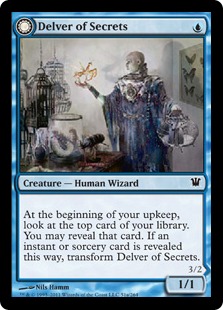 Since Innistrad, Grow decks in all formats have played Delver of Secrets, a card tailor-made for the archetype. The main difference between Fish and Grow lies with threat density. Grow employs fewer threats, but expects each of them to get the job done by itself: a transformed Delver of Secrets will end games a lone Silvergill Adept could never hope to. Grow decks offset this low threat density with cantrips to find the right combination of creatures and answers at the right times. They play flexible, efficient spells, among which Lightning Bolt reigns as king in Modern. Compared with Fish, Grow gives up some game against Aggro for improved Combo and Control matchups.
Since Innistrad, Grow decks in all formats have played Delver of Secrets, a card tailor-made for the archetype. The main difference between Fish and Grow lies with threat density. Grow employs fewer threats, but expects each of them to get the job done by itself: a transformed Delver of Secrets will end games a lone Silvergill Adept could never hope to. Grow decks offset this low threat density with cantrips to find the right combination of creatures and answers at the right times. They play flexible, efficient spells, among which Lightning Bolt reigns as king in Modern. Compared with Fish, Grow gives up some game against Aggro for improved Combo and Control matchups.
Strong against: Control and Combo. Cheap threats and soft permission are nightmares for these decks.
Soft to: Aggro, which outnumbers and outclasses most Tempo creature suites, and Midrange, Tempo's natural predator in Modern thanks to the following sentence: "Abrupt Decay can't be countered by spells or abilities."
Example Grow decks: Monkey Grow, iGrow, UR Delver
Aggro-Control Hybrid: Midrange
Aggro decks watered down to have an edge against fair strategies. Midrange either drags the game out to a certain stage in which it consistently casts high-powered spells, or accelerates itself into that stage. Its threats usually follow disruption, so they can afford to cost a little more. As such, midrange is often referred to as "goodstuff," and packs the format's most impactful (and expensive) cards. Like Tempo decks, Midrange decks can be split into two categories.
Rock
These decks get their name from the apparent resemblance of Phyrexian Plaguelord, once a mainstay in BGx attrition decks, to Dwayne Johnson. 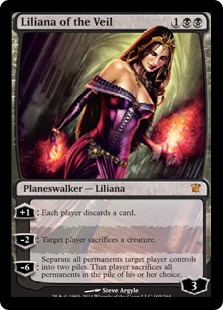 Rock exemplifies the midrange credo, dismantling an opponent’s hand and board and chasing the carnage with a huge threat. Modern’s Rock decks favor Tasigur, the Golden Fang and Tarmogoyf for the role of attacking funeral procession. Compared with pure Control, Rock can use its creatures to pressure Combo opponents early, effectively becoming Tempo decks for those matchups. On the name: while “Rock” has traditionally referred to black and green decks, I’ll use it here (and in the future) to refer to any deck with a similar midrange gameplan, regardless of color.
Rock exemplifies the midrange credo, dismantling an opponent’s hand and board and chasing the carnage with a huge threat. Modern’s Rock decks favor Tasigur, the Golden Fang and Tarmogoyf for the role of attacking funeral procession. Compared with pure Control, Rock can use its creatures to pressure Combo opponents early, effectively becoming Tempo decks for those matchups. On the name: while “Rock” has traditionally referred to black and green decks, I’ll use it here (and in the future) to refer to any deck with a similar midrange gameplan, regardless of color.
Strong against: Aggro, fair decks, and the linear decks Rock prepares for.
Soft to: Control, which owns the late game Rock aspires to while blanking archetype staples like Abrupt Decay and Lightning Bolt. Combo decks also trump Midrange, which doesn't always draw its relevant disruption.
Example Rock decks: Jund, UWR Flash, Grixis Control
Ramp
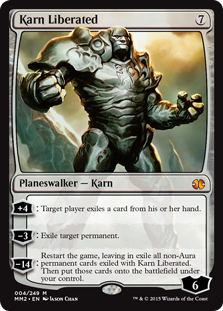 Ramp strategies occupy a strange place among Midrange decks, as it trades interaction for mana acceleration and expensive bombs. It ends up losing to Tempo, but beating other Midrange decks, as well as many Control strategies. Unlike other Midrange decks, Ramp strategies are unfair.
Ramp strategies occupy a strange place among Midrange decks, as it trades interaction for mana acceleration and expensive bombs. It ends up losing to Tempo, but beating other Midrange decks, as well as many Control strategies. Unlike other Midrange decks, Ramp strategies are unfair.
Strong against: Non-Tempo fair decks, Aggro, Midrange, and Control. Ramp stabilizes against Aggro, and against Midrange and Control, whoever goes "bigger" takes the trophy. Spoiler alert: nobody goes "big" like Tron.
Soft to: Combo, Aggro-Combo, and Tempo. The first two simply race the Ramp deck, and Tempo chips away at its life while preventing it from doing anything gamebreaking.
Example Ramp decks: GR Tron, Devotion to Green, Death Cloud
Aggro-Control-Combo Hybrids
The G-Class of all deck archetypes. Aggro-Control-Combo buys tempo by threatening a combo finish, which improves its midrange or tempo plan. Splinter Twin combo is Modern's resident Aggro-Control-Combo deck; it changes roles seamlessly depending on the matchup. Evidently, slapping a four-mana aura on a three-mana creature isn't a great strategy on its own, but Twin gets its power from its unmatched adaptability. Aggro-Control-Combo is proactive or reactive depending on the deck, and fair or unfair depending on the matchup. It's always interactive.
While some Abzan Company decks run both disruptive elements (Abrupt Decay) and an "Oops-I-Win" (Redcap/Melira/Seer), the deck seems too linear, and scattered, to make it as an Aggro-Control-Combo deck as of this write-up. But, its late grandaddy, Birthing Pod, much like Twin, typified the archetype. The Angel Pod variant played a superb midrange game with Decay, Thoughtseize, Shriekmaw, and Siege Rhino, but could also combo into a million life/damage with Spike Feeder and Archangel of Thune.
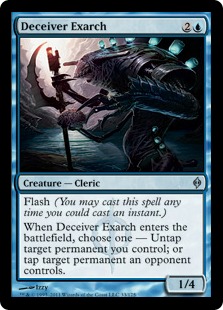 Strong against: The field. Aggro-Control-Combo doesn't "crush" any one strategy, instead boasting game against everyone. This versatility explains Twin's continued relevance in Modern (since the format's inaugural Pro Tour!).
Strong against: The field. Aggro-Control-Combo doesn't "crush" any one strategy, instead boasting game against everyone. This versatility explains Twin's continued relevance in Modern (since the format's inaugural Pro Tour!).
Soft to: Tempo. Grow decks especially can pose problems for Aggro-Control-Combo, which dons the Aggro-Control cap here and struggles to play a tempo game against decks designed for that purpose. Delver of Secrets gets in under counterspells, and soft permission proves especially potent against haymakers like Batterskull.
Example decks: Twin, Birthing Pod (RIP)
Pigeonholing and You
The most important thing a tournament-bound Magic player can do in the preparation stage is categorize decks and recognize archetypes. Armed with an understanding of Modern's classic and hybrid archetypes, strategic tweaking becomes a breeze. Everyone playing Midrange? Add some late-game control elements to your Abzan deck. Everyone playing Control? Break out those Delvers. Heading into an unknown environment? Sleeve up your favorite deck and pigeonhole opponents on the fly to improve your sideboarding.
This article dealt mostly with Modern, but the principles discussed apply to most formats. Demand depending, I'll cover Modern's mini-archetypes, such as Burn, in another article. Until then, happy metagaming!






How is Jeskai Controls lategame better when Grixis has Man-lands and Grixis Control has all the same Snapcaster interactions for CA as Jeskai with the addition of Kolaghan’s Command to rebuy Snapcasters? It just seems to me that when you actually play the MU and get a feel for the roles each deck needs to take the Grixis deck’s ‘Control’ role is much stronger given the amount of CA they can build.
I think you are completely wrong in thinking the Jeskai deck is remotely positive against the Grixis Control deck. And I would invite you to test the MU on the table in 3 game sets with good pilots and good SB plans.
Grixis Control utterly manhandles Jeskai if you SB in Fulminator Mage for G2 and G3. And on top of that you can use a SB flex slot to side in a Mulldrifter for the slower MUs; That makes Snap Cryptic look like garbage.
Jeskai has trouble resolving Cryptics against a deck that loves to SB in Dispel. Jeskai also has trouble building a SB as they are traditionally stuck between a rock and a hard-place with their SBs; yo-yo’ing between cards to shore up their aggro MU, cards to shore up their combo MU, and cards to shore up their control MU.
The rest of the article is sort of all over the place. I’m not really sure if you’re arguing against pigeonholing or if you’re supporting it.
You pigeonhole decks into very specific groupings and ignore the shifting roles many decks have; especially in the highly polarized format that is Modern many decks take on the “Control” role when they don’t want to (Typically if you’re SB’ing in niche hatecards to prevent a strategy from going around you or over the top of you, you’re playing “Control”). You also ignores SB plans. And the archetype “gradient” laid out by Chapin. Which I think is a much better model when discussing deck archetypes and roles in MUs, then simply “Rock beats Scissors”.
Simply put you can’t ignore powerful synergies that go ‘over the top’ or ‘around’ certain strategies. Especially in a format like Modern filled with hate-cards that far exceed the powerlevel of the more general answers and questions. Making wide statements like ‘Control beats Midrange’ is sort of silly when the ‘Grixis Midrange’ deck roflstomps the ‘Jeskai Control’ deck.
Also, Aggro-Control and Tempo are two different archetypes. Calling Twin ‘Aggro’ is entirely incorrect.
I figured Jeskai’s lategame is better because of Spinx’s Revelation and Gideon Jura/other spicy planeswalker, but this is not a matchup I’m very familiar with. I have a friend who plays UW Control and he dominates all the Grixis players in his meta, but that is a different deck from UWR.
I addressed that decks shift roles in my paragraph about proactive vs. reactive. As for “rock beats scissors,” obviously it’s never this easy. Decks win their bad matchups all the time, and some matchups in the format violate the “rock beats scissors” formulas I’ve laid out. When talking about archetypes, it’s important to get it MOSTLY right, since we could never generalize at all if we didn’t make some more blanket statements that are incorrect in corner cases. Yours is an issue many people take with generalizing, but I posit here that possessing an ability to categorize decks helps Magic players adequately prepare for tournaments. If a certain midrange deck has a great matchup against a certain control deck, I’d react more with an “Oh, that’s interesting. It’s not usually like this,” than an “Oh, my entire system must be wrong, back to the drawing board.”
According to my definition, tempo is an aggro-control deck. I know some others don’t define it that way, but IMO it becomes very confusing not to. For example, I’ve seen people refer to tempo and aggro-control as interchangeable terms and call midrange its own archetype entirely, when really tempo and midrange are incredibly similar. You could make the argument that some aggro-control decks are more “control” than “aggro,” and many of them are (Grixis Control, for instance, is more “control” than Jund). But that’s to be expected, as all the aggro-control decks (and all decks, really) exist on a spectrum (in this case, aggressive-controlling).
Twin isn’t an “aggro” deck. You’d be hard pressed to call Grixis Control an aggro deck, too. But it’s a midrange deck by just about any definition you choose, and many also refer to it as a tempo deck. Midrange and tempo are aggro-control strategies, and twin wears the aggro hat in a handful of matchups – sometimes even as a plan B. Since it plays every rule fluidly, it earns the aggro-control-combo moniker.
Hope this clears some things up! And of course, while I stand by my theory, there are many others that might do a better job of explaining archetypes for you. There’s never a right or wrong answer with this kind of thing.
As a UWR control player, i have never lost to grixis control. The reason being i can become a burn deck and win via that method. You effectively blank half their hand because you dont use creatures sides snap. Also, geist of saint traft adds a difficult tempo element tjat grixis striggles to answer, finally path to exile ensures that they are not able to recurr any of their creature based threats.
I buy that you can start sending burn to the dome, but saying Grixis “struggles to answer geist”? That’s a joke, isn’t it?
Tasigur walls your 2/2. Heck, I’ve flashed in a snapcaster to block, then flashbacked Kommand to retrieve the snapcaster.
Actually, I think Grixis Control is favoured in the Grixis vs Jeskai matchup. I know MTGOGoldfish lists it as favourable for Grixis in 80 matches. To say it’s favourable for Jeskai without stats and in the face of contradictory stats is a bold claim. Oddly enough, you later on talk about how The Rock is unfavoured against control, but my experience playing the matchup says The Rock is favoured against Jeskai. That’s what MTGOGoldfish stats say too, that Jund has almost a 75% win ratio against Jeskai.
Jeskai has always had a difficult time trying to end games. It can certainly stall out the game, probably pretty reasonably against Grixis, but where does that get it? Cards like Fulminator Mage and Kolaghan’s Command are huge amounts of value for Grixis, more than UWR can adequately handle. You can’t reasonably expect to win counter wars because they play roughly the same amount. Grixis Control having cheap threats is very powerful for the matchup because it can attempt to be proactive much earlier.
I think it’s hardly fair to say that only combo is heavily represented in Modern. In fact, this website’s stats contradict them. Of the tier 1 and 2 decks, combo is 28.1%, and aggro decks are 26.7%. This stat actually favours aggro if you cut to only tier 1 decks, as you have 10.1% combo and 21.3% aggro.
I disagree with a bunch of your assessments on where decks fall in the spectrum. I can’t possibly see Affinity being an aggro-combo but then Burn being only an aggro. They’re both winning through creatures, Burn less so than Affinity, actually. They both have this turn 4 ideal win as well, so it’s hard for me to think Affinity is more unfair than Burn is. Similarly, I think it’s difficult to call Infect an aggro-combo deck, since it’s trying to kill you in a single turn; the fact that it has some resiliency doesn’t change how it approaches the game.
And of course, as I’m sure will be pointed out, Twin is definitely not an aggro deck. The Twin deck is never going to win quickly. They might be flexible enough to be the combo, tempo, or control deck in any matchup, but never the aggro deck. They don’t try to race an opponent because they’re pretty bad at it, remembering that they cut a bunch of cards that could add speed in order to play slower cards like Remand and Spell Snare, that disrupt the opponent.
I didn’t know about MTGOGoldfish but that’s a sweet resource! On the Jeskai vs. Grixis matchup, another reason I thought Jeskai might be favored is its ability to string Bolts together, something Grixis has trouble recovering from, and use Path to Exile to remove Grixis’s limited delve threats permanently and cheaply. But as you showed above, all signs seem to point to Grixis actually having the edge in this matchup.
Aggro isn’t as heavily represented as you think, since most of Modern’s “aggro” decks are actually aggro-combo according to this archetype theory. It was tough deciding to slot Burn into aggro or aggro-combo, but I settled on aggro because it rarely kills opponents “out of nowhere;” Burn decks usually frontload some damage with creatures and then draw into Bolt effects to close out games. Affinity can topdeck one card (Ravager, Plating, even Disciple in some recent builds) and suddenly have 20 damage. Infect sits somewhere between the two, but given its ease reaching 20 points of damage and its tendency to limit interaction to cards protecting their win condition like Dispel, I figured it was closer to combo than to aggro compared with Burn. Again, everything is a spectrum, and I made some judgment calls here.
Twin never plays like an “aggro” deck, but it almost always plays like a tempo or midrange deck, and tempo and midrange are aggro-control in this model for the reasons listed in the section. S P E C T R U M
I enjoyed the comprehensiveness of this breakdown. I agree with most of it, though I would argue that some matchups are too close to call one way or the other, and thus this analysis would benefit from a “Could go either way” matchup, even if it would be blank for some of these decks. As for deck specific comments…
1. I agree with your decision to put Grixis Control in the midrange bin. EThat sells its late game a tad short, but it comes closest to describing the deck’s strategy and overall flexibility.
2. Control has a plan against Aggro, but that doesn’t necessarily mean it’s favored. There’s a reason that UWR is probably the most long-term approach in the format (rivaled by mostly just Tron), and it’s that aggro/aggro-combo/tempo will get you if you durdle around too long.
3. I think that ramp as a midrange category was a bit of a stretch. Tron doesn’t have an aggro bone in its body, and IMO is most similar to Scapeshift in that it’s just trying to buy time until it can scrounge together the mana to beat you over the head with a Karn or something. Yes, it’s leaking harder on the combo than Scapeshift is, but it’s the same general category.
Just a correction for my own post – Tron is leaning on its combo aspect more than Scapeshift is, not leaking. Now that I’m here, I might as well suggest where your examples for Ramp Midrange fit better (IMO):
RG Tron – Combo-Control
Death Cloud – I’m unfamiliar with this deck, but at a glance I’d say it’s just another spin on a Rock deck.
Green Devotion – this deck feels like a less bursty Elves that doesn’t fold to sweepers, so I’m gonna say aggro-combo, though it may be just straight combo.
Tron doesn’t fit the qualifications for combo-control, since it doesn’t win in a “small window.” It benefits from games going very long since it has so much inevitability. That’s the trickiest deck to categorize; Green Devotion and Death Cloud are clearly midrange IMO. They accelerate themselves into an early mid-game, cast big creatures and planeswalkers, and start attacking you. Tron is closer to combo on the spectrum than these decks because it works to assemble its Urza lands and sometimes even opens with them (we’ve all been on the receiving end of a turn-three Karn).
Great article! I learned a lot
Great article. You do a good job of summing up some major theory articles and putting them into the modern perspective. Sorry if people got immediately thrown off by the Jeskai vs. Grixis bit at the beginning – their loss since they missed the real point of the article.
There is one thing I think is missing, acknowledgement of some opposing/different theoretical perspectives. The one with which I’m most familiar is the Strategic Archetype theory promoted by Adrian Sullivan, and many other – I don’t know why gets the original credit, that uses 7 working archetype definitions before you include the XXXX-combo hybrids. The 2 they use that you don’t address are hybrid control and the distinction between midrange beatdown and midrange control. The missing hybrid control archetype is probably the key difference here. Just yesterday Patrick Chapin classified Grixis control as a hybrid control deck (he is credited with inventing it after all) on the Master of Modern podcast. The gist is that hybrid control decks, unlike true control, eventually flip a switch and go aggressive and try to timewalk the opponent a couple times while they win with a big threat whereas true control wins through complete inevitability. Whether this matters in the long run, I don’t know
Additional resources:
Strategic Moments (addresses your readers concern about how who’s the beatdown changes during the game and doesn’t always stay with your strategic archetype: http://www.starcitygames.com/magic/fundamentals/16396_Sullivan_Library_The_Strategic_Moment.html
Aggro-Control vs. Hybrid Control: http://www.starcitygames.com/magic/fundamentals/23864_The_Death_Of_AggroControl.html
Midrange: http://www.starcitygames.com/magic/standard/17465_Sullivan_Library_Why_Midrange_Rules_Todays_Standard.html
Who’s the beatdown on crack: http://magic.tcgplayer.com/db/article.asp?ID=2754
One thing I think could really add to the overall debate is an investigation into whether certain colors are required for certain strategic archetypes. Most importantly, can you build aggro-control or hybrid control without blue?
Definitely possible: the article classifies G/W Hatebears as Fish tempo. B/W Tokens is usually classified as Aggro-Control; by this system, it’d also be a Fish tempo deck.
Yes on Tokens, but that deck is certainly closer to the aggro side of the spectrum than the control side. Same with Zoo, which is about as interactive as tokens, but in a different way (with removal and reach over removal and discard effects).
This article mostly just posits my own theory. It’s pretty lengthy so I’d rather keep the comparisons to other theories somewhere else. That said, I’m not familiar with most of the ones you posted but I’ll check them out and get back to you.
I did read the Drew Levin article on aggro-control and hybrid control, and I’ll contrast it to this one. Compared with my theory, Drew’s aggro-control is grow. As it moves closer to aggro (beatdown), it becomes fish. Zoo is between aggro and fish, and the 20 Savannah Lions deck is undeniably aggro.
Hybrid control is rock midrange. So is midrange control, and so is midrange beatdown. They’re all rock to me. I define midrange decks as aggro decks with control elements (or control decks with aggro elements) that disrupt opponents first, then commit threats to the board and attack to win. These decks make great use of tempo along the way, although unlike grow and fish decks, they’re wary of throwing cards away for the sake of tempo. Most of the “tempo” cards midrange decks play break parity at least on card advantage (Remand, Repeal, Smallpox, etc.).
What I call tempo decks are aggro with control elements (or again, control decks with aggro elements) that commit threats FIRST, and disrupt after. These decks also use tempo along the way, but they don’t mind throwing cards out for more tempo (Vapor Snag, Disrupting Shoal, etc.). That’s because they don’t have much of a lategame, whereas midrange decks do – after all, they’re most proactive in the lategame, after opponents have been disrupted.
UWR v grixis is 70-30, but which way hinges entirely on whether the UWR player has access to rest in peace. Grixis control grinds like crazy, but if UWR manages to resolve a rest in peace, the grixis deck all of a sudden is a pile of removal, some overcosted beaters, and a couple 2 for 1’s against a deck with sphinx’s revelation, sweepers, and planeswalkers.
Source: more than 20 3 game sets of grixis v UWR in the last week.
This makes sense to me, too. I don’t want to discount what others have said about the matchup, since I’m not expert, but I would assume Rest in Peace out of UWR hoses Grixis decks.
Okay fellas, please forgive my ignorance here but I’m not going learn unless i ask–how do you classify decks that push synergies between cards to gain advantage, but not necessarily for a combo like insta-win?
In regard I’m thinking of my own enbantments prison deck that’s utilizes the synergy of constellation cards like eidolon of Blossoms and/or enablers like Monastery Siege with Starfield of Nyx. I think the deck would certainly fall under the aggro/control umbrella of midrange as I ultimately win with creatures.
Additionally, are cards like ghostly prison and suppression field tempo cards or control cards? Or both?
Yep, that enchantment deck sounds like midrange to me. Prison cards are control elements, so they can fit into control decks, combo-control, or aggro-control (tempo and midrange). Ghostly Prison, for instance, could find itself in each of these archetypes.
I love articles about the metagame wheel. Have you ever read Chingsung Chang’s articles on the same topic? He argues that Aggro, Combo and Control are outdated ways of thinking. I’d love to hear your thoughts on this.
http://www.gatheringmagic.com/sculpting-formats-circle-predation/
http://www.gatheringmagic.com/circle-predation-part-2-indepth/
A decent read I must say. I really like articles like this and I even bought Next Level Magic from Patrick Chapin since game theory is just very interesting. That being said it’s only theory and I think you should have clarified that in your article. There is one mistake that many people make constantly and that is taking theory for granted and ignoring the actual context.
Black and white thinking like thinking that X beats Y or is good against it every time is an easy to actually lose games.
I see few things wrong here that I will address:
1) You say that Control is unfair but how? You classify unfair as winning in nontraditional ways, usually violating game rules. Since when is attacking with manlands or creatures or winning with planeswalkers or burn a violation of the game rules? I don’t see it.
2) Your Midrange section has several problems and I as someone who has kinda specialized in these kind of decks find them very noticeable:
2.1) You assume that Rock and midrange are basically the same which is false. While the Rock-style midrange decks are indeed most of the time the biggest and most successful kind of midrange decks in any format for many reasons they are still just a very specific kind of midrange deck and are not representative of the entire archetype.
Take for example a deck like Big Zoo/Naya Midrange. Are they midrange? Of course they are. They play stuff like Path to Exile and Lightning Bolt as removal and have big, efficient creatures like Loxodon Smiter, Knight of the Reliquary, Tarmogoyf and so on. They couldn’t be more different from the Rock though. They don’t attack the hand or the opponents resources in any way, they have little to no card advantage at all, they are not interested in long attrition battles. What they do though is stomping any kind of aggressive deck which was the original idea behind midrange. An aggro deck that is basically pre-sideboarded to win aggro mirrors. That’s why these kind of decks are indeed weak to the type of decks that you have mentioned. A Storm deck that is trying to go off with Pyromancer Ascension couldn’t care less about Path or Bolt or your Loxodon Smiter. That brings us to the next point though.
2.2) The Rock-style decks are certainly not weak to any kind of combo deck. In fact that is what the decks are preying on. Why do you think BG/x is called the police force and fun police of Modern? If your deck has a combo or the characteristics of a combo deck like Infect you will automatically will be the dog in the matchup when going against a deck like Jund. When you are playing combo you actually hope to avoid decks like Jund and Abzan. You can ask Storm players or Ad Nauseam players for example. They all dread playing against a deck like Jund. That’s why these kind of combo decks have been pushed out to the fringes. Twin doesn’t have good matchup either because the combo is simply bad against BG/x. That’s why stuff like Grixis Twin is even a thing to make their bad matchups at least a bit better and All-in Twin has ceased to exist.
The same is true for control to a lesser extent. The average Jund mainboard is already able to beat any kind of control deck game 1. It’s true that the removal is dead but the maindeck discard, Liliana of the Veil, fast clocks like Tarmogoyf, card advantage engines like Dark Confidant, manlands, Scavenging Ooze growing huge and invalidating Snapcaster Mage, etc are all hugely relevant and live and can already do the heavy lifting and after board things get even better with the useless removal leaving and more relevant cards coming in like Land destruction in form of Fulminator Mages and haymakers like Thrun, the Last Troll which can beat a control deck single-handily.
In my opinion it’ s like playing a BG/x mirror making it a mostly 50/50 matchup. You just take out all the removal instead of the discard when sideboarding.
The only type of deck that can undeniably claim to have decent BG/x matchup is GR Tron and even that one is far away from auto winning. That lies simply in the nature of Rock-style decks.
You see the same thing being true for Abzan in the current Standard, Mono-Black Devotion last Standard season, when Jund was big in Standard, etc.
3) Scapeshift is actually strong against control but weak to aggro. Scapeshift has a ton of counterspells and has the mana advantage thanks to the ramp spells making it tough to win counterwars against them after a certain point which will be reached thanks to control having no clock not to mention Boseiju, Who Shelters All which invalidates basically the entire control deck. Scapeshift has huge trouble with early pressure though since it doesn’t have much removal and is so reliant on counterspells to be relevant and stuff like Remand is garbage against aggro as is Cryptic Command. That’s why the deck has fallen of the map for the most part. The deck is unable to beat both BG/x and aggro since you lose to BG/x if you pack more removal for the aggro matchups and if you play more card selection against BG/x you lose to aggro not to mention the omnipresence of land destruction thanks to decks like Tron or Amulet Bloom being in the meta too.
I should maybe have clarified that this was only a theory. I took for granted that readers would understand that, but as the first few comments indicate, that’s not what happened.
Another thing I should have addressed is that the matchups (strong against/soft to) are by no means set in stone and vary depending on players, playstyles, decks, and other circumstances. But I’ll stand by my claim that control decks generally beat midrange decks, as well as most of the others I make, even if they prove untrue in some cases.
I also really like discussing theory, so I’ll respond to your points!
1) I say in the article that I’m defining unfair as a deck that wins in a way other than attacking with creatures fairly consistently over the course of a game, or can end a game from “0” (i.e. with an opponent at 20 life, or 0 poison) in a single turn. “Fair” is one of the most contentious terms in Magic, since different players “feel” like some strategies are more fair than others and bring their own definitions and biases to the word. That’s why it’s so important to clearly define it. The only grey area in my definition is how to measure the “consistency” of these attacks, but I think it’s impossible to completely eliminate gray areas with definitions like these.
2) Your claim that “rock” and “midrange” ignores that this article only proposes my theory. In this theory, rock is a sub-division of midrange, so actually yes, rock is a midrange deck. I locate the Naya Zoo decks between midrange and tempo, depending on the build; the “bigger” CoCo decks are closer to rock, as they aim to accrue advantage over time with cards like CoCo and Knight of the Reliquary (so yes, they do have sources of card advantage). Small Zoo is a fish deck, backing a bunch of cheap creatures with enough disruption to “get there.”
2.2) The BGx decks are indeed rock decks that boast game against combo, mainly because of hand disruption. That said, they have less game against these strategies than blue rock decks like Grixis Control, which has better answers and can play proactive games of a similar caliber with Scour-Tasigur for quick beats or even EOT-deployed Snapcaster Mages. All that said, these decks especially prey on fair decks. When it comes to beating combo (we’ll use Storm as an example, since you pointed it out and it’s clearly a pure combo deck), the grow deck will outperform the rock deck any day of the week. That’s because tempo decks like grow are aggro decks watered down to beat unfair strategies like combo. Midrange decks, like rock, on the other hand, can obviously perform against combo, but crush fair decks like no other. At the end of the day, Siege Rhino and Lingering Souls are way better against Wild Nacatl decks than against Pyromancer Ascension decks, whereas almost every card in RUG Delver contributes to a cohesive plan against Ascension decks.
On Jund vs. Combo: of course Jund can win. But it’s “natural” plan – of disrupting opponents, then beating down with threats – matches up poorly against control decks, which have the same “natural” plan but execute it much more succinctly. Take the Jund vs. Esper Control matchup, for example (and yeah, Esper Control is horrible). Jund is forced into an aggro role here, which can obviously work for it sometimes. But Esper is the clear favorite here. It stops Jund’s attrition plan with Think Twice, Esper Charm, and Think Twice, has Pulse-me-or-die threats like Gideon Jura, can ravage Jund’s aggro plans with Supreme Verdict, and boasts an insane late-game spell in Sphinx’s Revelation. As you pointed out, Tron sits at the top of the “go long” hierarchy, even beating most control decks because its ramp is just so strong. Midrange decks presumably deserve their name because they are situated “between” aggro and control, and can fluidly adapt their roles depending on the matchup – Jund is an aggro deck against Ad Nauseam and a control deck against Zoo, for example. It’s more true of Abzan than of Jund, but in general, BGx has a much stronger late-game than it does an early-game, and I believe that decks with better late-games than BGx tend to beat it.
3) Which aggro decks are you referring to? It seems to me that Scapeshift is mostly soft to aggro-combo if anything, and to tempo decks, of course.
I agreed with your comments up until “and yeah, esper control is horrible”. The deck is solidly tier two in power level, and has plenty of game against the format. I took it to the DC premiere IQ a week ago, and I went 4-4 despite playing only one round against a deck I was even remotely prepared to sideboard for. I had eleven sideboard cards that remained 100% untouched at that event because I didn’t play against twin, affinity, grixis of any flavor, or burn even once, and only against jund once; the only tier two decks I played against were co-co elves (with dwynen’s elite) and infect. A dedicated control deck that can 4-4 an 8 round tournament with essentially a four card sideboard is definitely not “horrible”.
I don’t consider 4-4 an impressive record by any means, but am open to looking at some actual data suggesting Esper Control’s viability in Modern.
Nor do I consider 4-4 to be impressive; the point wasn’t that it was a good finish, but rather that it, as a deck that was prepared heavily for the tier one and two metagame, with some very positive and some very negative matchups among those tiers, can still perform reasonably against a completely random sweep of the lower tier decks. One of the things that often plagues decks on the verge of breaking out (see grixis before kolaghan’s command) is the inability to perform reasonably against other decks in the lower tiers because of the concessions they make to have reasonable matchups against tier one decks. A 4-4 record against the swath of random decks mirrors the 50-50 “game against anything” style performance that makes BGx decks so attractive–you can metagame for what you expect, but still presume to have a 50/50 matchup or close to it against pretty much any opponent.
I don’t consider 4-4 “reasonable,” either. If you can tune to beat the top decks, great, but your deck still has to be good enough to get past the “other decks” to be good enough for Modern. Take Monkey Grow: it’s a heavily metagamed deck that shines against top-tier strategies. Cards like Blood Moon or Disrupting Shoal are bad against a lot of random outlier decks. But the sheer power of Delver, Bolt, Snapcaster, Tarmogoyf, Huntmaster, etc. floats the deck through those matchups anyway. Esper doesn’t really have cards that do that.
Again, I disagree–I think esper DOES have the cards to float through the other matchups within reason–for example, supreme verdict isn’t exactly the best positioned at the moment among modern’s decks, but it really won’t take that much of a metagame shift to make sweepers more powerful. Path to Exile and Snapcaster mage both stand on their own as powerful cards in their own right, and celestial colonnade has a strong pedigree in the earlier years of modern. If the random other decks I encountered were more aggressive decks, like the white weenie list recently featured here, or some tribal strategies, or even outliers like blue-tron or delver strategies, the story could have been much different. Those are decks that esper has tools that are well positioned for. 5 color kiki shenanigans? Naya collected company with mainboard gaddock teegs? Those aren’t the types of decks that the tools esper has are good against. If those rounds had been white weenie (the top 16 list) and/or some kind of tribal strategy, I could just as easily have been 6-2. Don’t discount decks that have strong potential just because the tools that they best abuse aren’t positioned well at the moment, because all it takes is one banning or one printing of the right kind of card to push wraths and card draw towards the front of the format.
The beautiful thing about the current Grixis builds is that they can seamlessly transition from a game one ‘midrange’ approach to a tempo-oriented deck with 4 Dispels after sideboard. That gives the deck a lot of play against the ‘pure control’ decks that might try to push it out of the meta, especially if the Grixis decks come prepared with hard to remove threats like Bitterblossom in the board.
Switching between tempo and midrange builds post-board is common of both these archetypes. In iGrow, I frequently side out my Swiftspears and Undoings to play a midrange game with Snapcaster Mage and a ton of removal (against every aggro deck).
Great article; I love this content!
This has already been mentioned, but I wanted to reinforce.
As a long time scapeshift player I can confidently say that control is probably the easiest matchup. The toughest matchups are: delver or other aggro control variants, super fast (pre turn 4) combo decks, and hyper aggro (non-affinity) decks. I think that the deck is unique among combo control in that the lands theme gives it a huge mana advantage against control decks.
I know that in magic history, combo control was probably weak to straight control, but in the modern context, combo control generally trades favorably with counter magic, has virtual card advantage (lots of dead cards in the control deck) and has a proactive plan that threatens to win, even from a losing position.